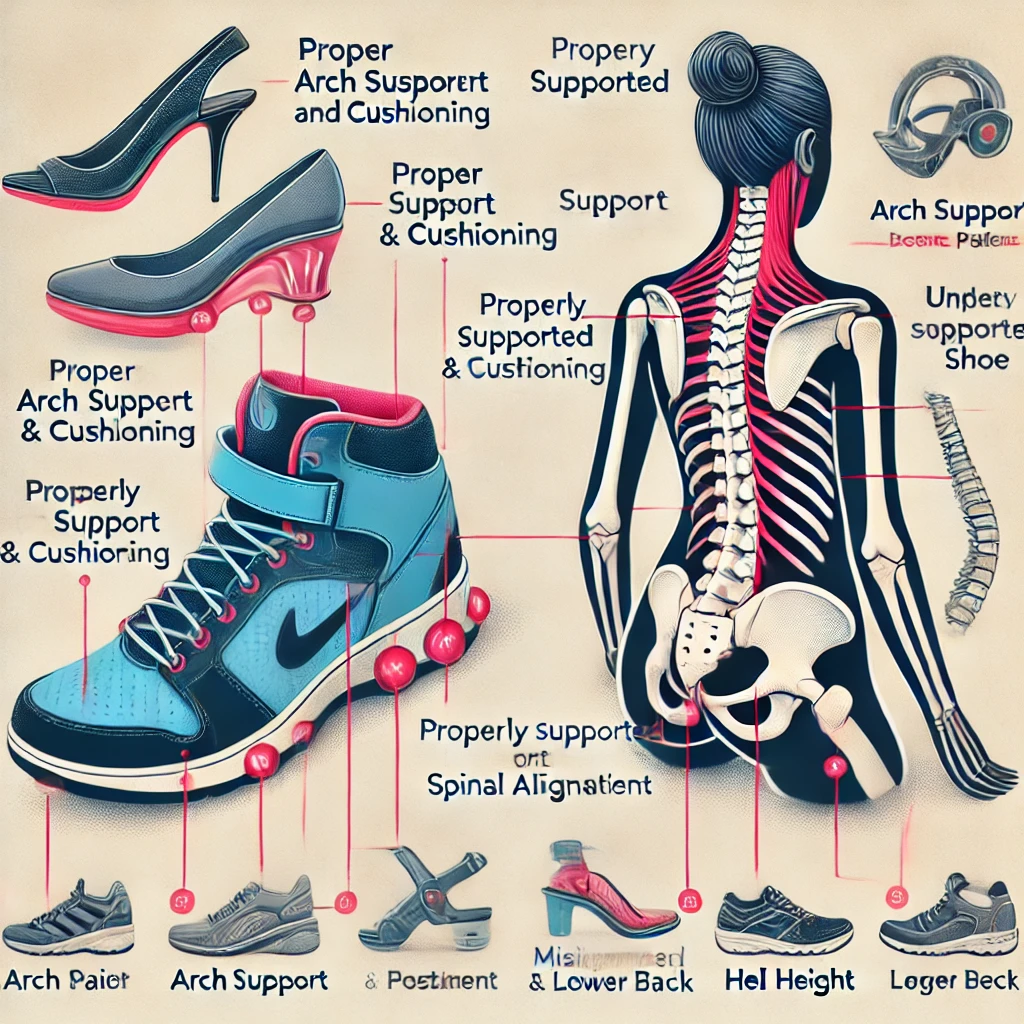Back pain is a common ailment that affects millions of people worldwide. While many factors contribute to back pain, one often overlooked aspect is footwear, especially when it comes to finding the best shoes for back pain. The shoes you wear can significantly impact your posture, gait, and overall spinal health. In this blog post, we will explore the role of footwear in back pain and provide tips on choosing the right shoes to alleviate and prevent discomfort.
Understanding the Connection Between Footwear and Back Pain

The human body is a complex system where everything is interconnected. When you walk or run, the way your feet hit the ground affects your knees, hips, and ultimately, your spine. Poorly designed or ill-fitting shoes can disrupt this natural alignment, leading to various issues, including back pain. Here’s how footwear can influence your spinal health:
- Posture and Alignment: Shoes with inadequate support or improper design can cause you to adopt poor posture. This misalignment places additional stress on your lower back muscles and spine, leading to pain and discomfort over time.
- Shock Absorption: Each step you take generates a force that travels up your legs to your spine. Shoes with insufficient cushioning fail to absorb this shock effectively, increasing the impact on your lower back and contributing to pain.
- Arch Support: The arches of your feet play a crucial role in distributing body weight evenly. Shoes without proper arch support can cause your feet to overpronate (roll inward) or supinate (roll outward), leading to imbalances that affect your back.
- Heel Height: High heels shift your body weight forward, forcing your lower back to arch excessively to maintain balance. This unnatural posture can strain the muscles and ligaments in your lower back, leading to chronic pain.
If you’re experiencing lower back pain, you might find our blog on:- Non-surgical solution for lower back pain
Choosing the Best Shoes for Back Pain Relief
Selecting the appropriate footwear can make a significant difference in managing and preventing back pain. Here are some essential tips to consider when choosing shoes:
- Prioritize Comfort: Comfort should be your top priority. Look for shoes that fit well and provide ample cushioning. Avoid shoes that pinch or rub, as these can cause blisters and other foot problems.
- Supportive Soles: Opt for shoes with sturdy, supportive soles that provide adequate arch support. This helps maintain proper alignment and reduces strain on your back.
- Cushioning and Shock Absorption: Choose shoes with good cushioning to absorb the impact of each step. This is especially important for activities that involve a lot of walking or running.
- Low Heel Height: If you wear heels, choose those with a low heel height (preferably less than two inches). Avoid high heels, which can throw off your balance and posture.
- Custom Orthotics: If you have specific foot conditions or chronic back pain, consider getting custom orthotics. These are specially designed shoe inserts that provide additional support and alignment tailored to your needs.
- Regular Replacement: Over time, shoes lose their support and cushioning. Replace your shoes regularly, especially if you notice signs of wear and tear.
Types of Footwear to Consider
Certain types of footwear are known for their supportive features and comfort, making them suitable for individuals experiencing back pain:
- Running Shoes: Designed for shock absorption and support, running shoes are an excellent choice for everyday wear, even if you’re not a runner.
- Orthopedic Shoes: These shoes are specifically designed to support foot health and alleviate various conditions, including back pain.
- Athletic Shoes: Cross-trainers and walking shoes offer good support and cushioning for a variety of activities.
- Casual Sneakers: Many modern sneakers combine style with comfort and support, making them a versatile option for everyday use.
You may find some best shoes for back pain on Amazon
Tips for Buying Shoes
- Shop Later in the Day: Your feet swell throughout the day, so it’s best to shop for shoes in the afternoon or evening to ensure a comfortable fit.
- Test Them Out: Walk around the store to test the comfort and support of the shoes before making a purchase.
- Consider the Shoe’s Purpose: Different activities require different types of shoes. For example, running shoes should provide cushioning and support for impact, while hiking boots should offer durability and traction.
- Measure Your Feet: Ensure you have an accurate measurement of your feet to avoid buying shoes that are too tight or too loose.
- Consult a Professional: If you have chronic back ache, consider consulting a podiatrist or orthopedic specialist for personalized recommendations.
Conclusion
Footwear plays a crucial role in maintaining your overall spinal health, especially when it comes to finding the best shoes for back pain. By choosing shoes that offer proper support, cushioning, and alignment, you can significantly reduce the risk of back pain and improve your quality of life. Remember, investing in the right pair of shoes is an investment in your health and well-being. Take the time to find footwear that meets your needs, and don’t hesitate to seek professional advice if you experience persistent back pain. Your feet—and your back—will thank you!
